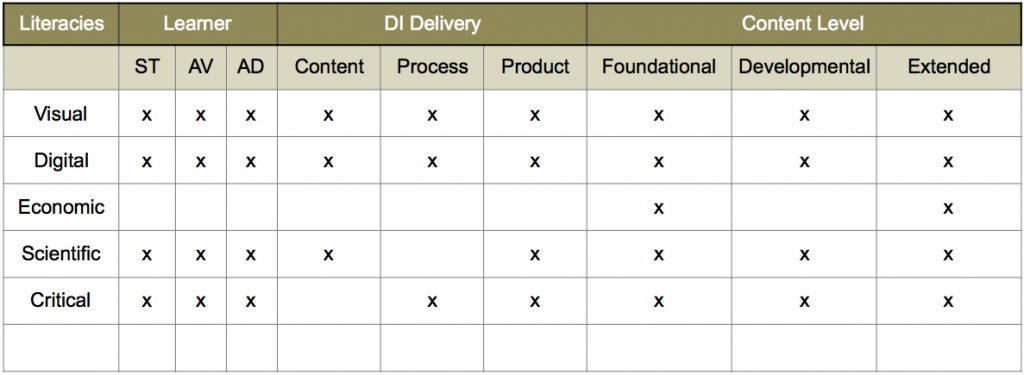This exhibit introduces students to the habits and practices of scientists, while still practicing Team Agreement skills. The ancient past is made relevant to Kindergartners as they take on the persona of a paleontologist. By learning to read bones, or artifacts, students are introduced to how stories of the past inform us (Tincher, 2016, Module 3, Part 1). Carpenter (2011) notes, “scientific practice requires the use of multiple literacies” (p. 18), and with this exhibit Kindergarten students further engage their critical literacy through examination of tradition texts, interactive digital media, dissection of visual images, reading artifacts, and practical issues paleontologists might encounter out in the field.
Wells (as quoted in Jewett, 2013) affirms that for learning to “constitute a genuine apprenticeship into the different disciplines” (p. 19) students need to engage in the tools of each discipline. In this exhibit students will critically examine paleontologists’ tools, discuss their purpose or use, connect that information to their prior knowledge, and then use similar tools themselves to uncover ‘dinosaur’ bones from the school sandbox. In this way they are experientially engaging in scientific literacy. Rudimentary economic literacy is introduced when students are given a limited budget to buy tools for their ‘dig’. This forces them to critically examine the site, and extrapolate information from our tool discussion to establish what types of tools they will need before they make a ‘purchase’ (Bamberger & Cahill, 2013, p. 179). Economic literacy is also encouraged through the graphing dinosaurs studied, and the story the graph tells of food consumption (Tincher, 2016, Module 3, Part 2).
As critical thinking is key to 21st century skills (Higgins, 2014, p. 562), throughout all activities students are encouraged to use critical literacy as they question, reason, and defend their understandings. In this way they enhance not only their scientific thinking skills (Deming, O’Donnell & Malone, 2012, p. 11) but get a “more authentic picture of the rhetorical practices of scientists” (Washburn & Cavagnetto, 2013, p. 129) and scientific literacy. Engagement is assured as students “choose the activities they consider to be the most relevant ones to their own interests (Gün, 2013, p. 95).

References
Bamberger, Y., & Cahill, C. (2013). Teaching design in middle-school: Instructor’s concerns and scaffolding strategies. Journal of Science Education & Technology, 22(2), 171-185.
Carpenter, J. H. (2011). A “layered literacies” framework for scientific writing pedagogy. Currents in Teaching & Learning, 4(1), 17-33.
Deming, J. J., O’Donnell, J. R., & Malone, C. J. (2012). Scientific Literacy: Resurrecting the Phoenix with Thinking Skills. Science Educator, 21(2), 10-17.
Gün, E. S. (2013). The reflections of layered curriculum to learning-teaching
process in social studies course. International Journal of Instruction, 6(2), 87-98.
Higgins, S. (2014). Critical thinking for 21st-century education: A cyber-tooth curriculum?. Prospects, 44(4), 559-574.
Jewett, P. (2013). Content-Area Literacy: Recognizing the Embedded Literacies of Science and Mathematics. Journal Of Reading Education, 38(2), 18.
Scholastic, (n.d.), You dig. [Video game]. Retrieved from http://www.scholastic.com/play/dig.htm
The Age of Dinosaurs., (n.d.). The Burke Museum in a Box. [Media kit]. Retrieved from http://www.burkemuseum.org/programs/burke-boxes
The Age of Dinosaurs, (n.d.). [Interactive video]. Retrieved from http://www.burkemuseum.org/static/burke_boxes_materials/dinos/
interactive/Dinos.html
Unknown, (n.d.), Camarasaurus. [Image]. Retrieved from
http://www.dinocreta.com/extreme-dinosaurs/dinosaur-fossils-facts-for- kids.html
Unknown, (n.d.), Paleontologyist’s tools. [Image]. Retrieved from http://nmnh.typepad.com/100years/fossilab/
Unknown, (n.d.), Parasaurolophus. [Image]. Retrieved from http://dinosaurs- world.com/News/Beautiful-baby-dinosaur-delights-palaeontologists.html
Knockout Novelties, (n.d.), T. Rex. [Image]. Retrieved from https://www.amazon.com/Mounted-Dinosaur-Tyrannosaurus-Hanging- Display/dp/B007HKOM1O
Washburn, E., & Cavagnetto, A. (2013). Using argument as a tool for integrating science and literacy. The Reading Teacher, 67(2), 127-136. doi:10.1002/TRTR.1181